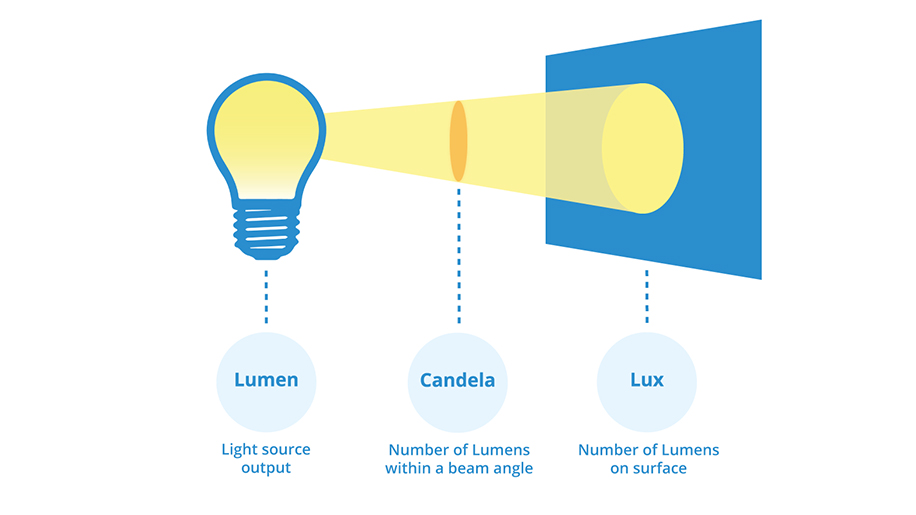When it comes to buying lighting stuff, you'll run into a bunch of tech terms like lumens, candelas, and lux, scattered all over the product blurbs. It's like a sudden downpour of confusing words, leaving you scratching your head and wondering what's what. Why can't they just speak plain English, right?
But worry not, my friend! This guide is here to shed some light on these fancy measurements, making sure your next light purchase doesn't leave you in the dark. Let's dive into the world of lumens, candelas, and lux and decode the secret language of light levels.
What Is Lumens?
Lumens are the go-to guys when it comes to measuring how bright a light is. They basically tell you how much light is pouring out in all directions. Think of it as the full blast of a light's awesomeness. So when you're checking out a flashlight, the number of lumens is like a sneak peek into how much oomph that thing's got.
To make it easier to wrap your head around, just remember that 1 lumen is the brightness you get from one of those small candles in a tiny room. This little comparison helps you figure out if your light's got the firepower to handle your specific needs.
Hold up, What's a Candela Then?
While lumens give you the big picture, they don't tell you much about how focused or intense the light is. That's where candelas come into play. They're all about measuring the intensity of the light in just one direction. So if you've got a flashlight that's all about throwing a narrow, strong beam, you'll want to check out its candela rating.
A high candela rating means your light's got some serious focus, perfect for cutting through fog or reaching far-off spots. But if you need a more laid-back, even spread of light, you might want to go for something with a lower candela rating.
What's a Lux?
Lux is like the golden ratio of how much light lands on a certain spot. Unlike lumens, lux gets affected by how far away the light source is. The farther it is, the less lux you get. Now, while lux isn't the talk of the town when it comes to flashlights, it's a big deal for fixed lighting setups. But since we're all about that portable life, let's just forget about lux for now.
Choosing the Right Light for Your Lair
Picking the perfect brightness for your different hangouts can totally set the vibe. Whether it's your kitchen, bathroom, or bedroom, getting the light just right can make a world of difference. So for your cooking hub, aim for around 70 lumens per square foot to keep things bright and cooking-friendly. And for your snooze sanctuary, a chill 20 lumens per square foot will set the mood just right for some serious shut-eye.
In a Nutshell
Let's quickly sum up the roles of these light metrics:

Lumens: They're the big shots, showing you how much light is pouring out in all directions. It's like the grand total of your light's coolness, so pay attention to this one.
Candela: They're all about that intense spotlight action, telling you how focused your light is beaming.
Lux: Now, lux is all about the amount of light hitting a surface, but here's the catch - it gets all wonky when the distance between your light and the spot changes. Let's just leave it at that for now.
Factors Affecting Candela, Lux, and Lumens Values
What's cooking in the world of factors that mess with these light metrics? A few things come into play:
Distance
The distance between the object and the light source directly affects the values of lux and lumens. As the square of the distance varies inversely with these units, an increase in distance leads to a proportional reduction in lux values. However, the value of candela remains unaffected by changes in distance, as it depends on the angle of radiation rather than the distance itself.
Angle of Radiance
The angle produced by the light source has a considerable impact on overall illumination. A smaller angle of radiance corresponds to higher values of candela and lux, resulting in a more intense and brighter light output. Conversely, larger angles of radiance increase the illuminated area without necessarily altering the value of lumens, highlighting the importance of considering the angle of radiance when assessing lighting solutions.
Luminous Efficiency
Luminous efficiency is a critical measure of a light source's ability to produce luminous brightness. It depends on the relationship between the power source's wattage and the lumens rating, emphasizing the energy efficiency and overall effectiveness of the light source. Lower wattage values lead to higher luminous efficiency and a brighter light output, underlining the significance of energy-efficient lighting solutions for optimal illumination with minimal power consumption.
So, armed with these nuggets of lighting wisdom, go forth and conquer your space with the perfect light for every mood and every moment!





